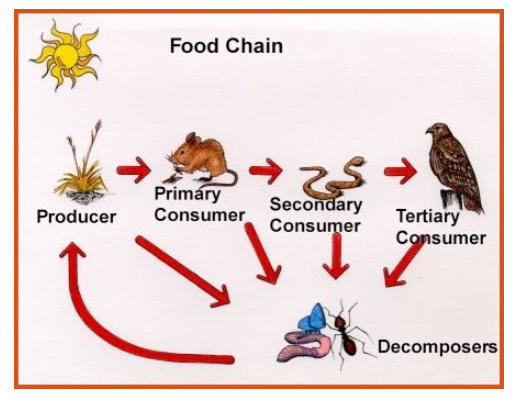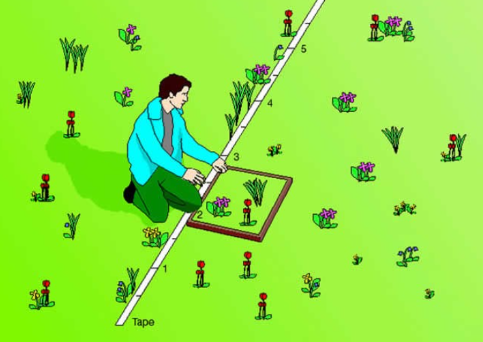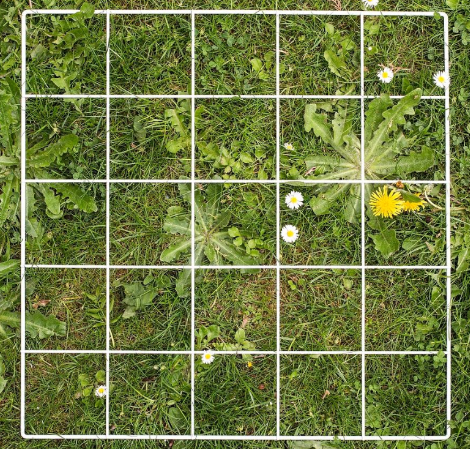Ecology
1.1 Adaptations, Interdependence and Competition
1.1.1 Communities
Ecosystem: The interaction of a community of living organisms (biotic) with the non-living (abiotic) parts of their environment.
To survive and reproduce, organisms require a supply of materials from their surroundings and the other living organisms there.
Different Levels of Organization in an Ecosystem
Individual Organism |
|
|---|---|
Population |
|
Community |
|
Ecosystem |
|
Biome |
|
Biosphere |
|
There can be competition within species or between different species.
Competition is a driving force in shaping the distribution and abundance of species within communities, as individuals must compete to acquire the resources they need to survive and reproduce.
Plants in a community or habitat often compete with each other for light space, water and mineral ions from the soil.
Animals often compete with each other for food, mates and territory.
Interspecific competition and intraspecific competition can regulate population sizes and densities within communities.
Interspecific Competition: competition between different species
Intraspecific Competition: competition within the same species
Interdependence: organisms needing other organisms to survive.
It facilitates the flow of energy and the cycling of nutrients within ecosystems.
It contributes to ecosystem stability and resilience by promoting biodiversity and functional redundancy.
Within a community, each species depends on other species for food, shelter, pollination, seed dispersal etc. If one species is removed it can affect the whole community.
A stable community is one where all the species and environmental factors are in balance so that population sizes remain fairly constant.
Results to population sizes to remain roughly constant.
Difficulty in replacing what has been lost.
1.1.2 Abiotic Factors
Abiotic (non-living) factors which can affect a community are:
Light Intensity |
|
|---|---|
Temperature |
|
Moisture Levels |
|
Soil pH and Mineral Content |
|
Wind Intensity and Direction |
|
Carbon Dioxide Level (Plants) |
|
Oxygen Level (Aquatic Animals) |
|
1.1.3 Biotic Factors
Biotic (living) factors which can affect a community are:
availability of food |
|
|---|---|
new predators arriving |
|
new pathogens |
|
one species outcompeting another |
|
1.1.4 Adaptations
Adaptation: the process by which a species becomes fitted to its environment.
Organisms have features (adaptations) that enable them to survive in the conditions in which they normally live.
Extremophiles: These are some organisms that live in very extreme environments, such as at high temperatures, pressure, or salt concentrations.
Example - bacteria living in deep sea vents
Adaptations may be structural, behavioural or functional.
Structural Adaptation: The changes in the structure of a living organism that enables it to adapt better to its environment.
Special attributes could consist of special body parts, such as skin, colour, and shape.
Example - a Giraffe's long neck helps them reach food high up in trees.
Behavioral Adaptation: It is something an animal does usually in response to some type of external stimulus in order to survive.
Example - Hibernating during winter & Courting behavior to attract a mate
Functional Adaptation: Involved in biological processes such as reproduction and metabolism.
Example - Conservation of water to produce little sweat & Late implantation of an embryo
1.2 Organisation of an Ecosystem
1.2.1 Levels of Organisation
Photosynthetic Organisms: (also known as photoautotrophs) are organisms that capture the energy from sunlight and use it to produce organic compounds through the process of photosynthesis.
They are the producers of biomass for life on Earth.
Examples - plants, algae, and cyanobacteria

Food Chain: It refers to the order of events in an ecosystem, where one living organism eats another organism, and later that organism is consumed by another larger organism.
“feeding relationships within a community”
The components of the food chain are;
Producers (autotrophs): are eaten by primary consumers, which in turn may be eaten by secondary consumers and then tertiary consumers.
This is usually a green plant or alga which makes glucose by photosynthesis.
Consumer (heterotrophs): are species that cannot manufacture their own food and need to consume other organisms.
Herbivores: Animals that eat primary producers (like plants).
Carnivores: Animals that eat other animals.
Omnivores: Animals that eat both plants and other animals.
Decomposer (detritivores): breaks down dead plant and animal material and wastes and releases it again as energy and nutrients into the ecosystem for recycling.
bacteria and fungi (mushrooms) - feed on waste and dead matter, converting it into inorganic chemicals that can be recycled as mineral nutrients for plants to use again.
A range of experimental methods using transects and quadrats are used by ecologists to determine the distribution and abundance of species in an ecosystem.

Transect Sampling Method: involves moving along a line or path to survey the distribution and abundance of organisms that intersect the line.

Quadrats Sampling Method: a stationary method that uses a series of fixed frames to sample organisms in a given area.
1.2.2 How Materials Are Cycled
All materials in the living world are recycled to provide the building blocks for future organisms.
Cycle: recycling of the one material
Chemicals in the ecosystem are looked at as compounds like water, or elements like carbon, nitrogen, sulfur, and oxygen.
Each of these is recycled by being transferred from one factor (biotic or abiotic) to another through different types of processes.
Types of Cycle
Carbon Cycle: refers to returning carbon from organisms to the atmosphere as carbon dioxide to be used by plants in photosynthesis.
It is essential for maintaining a stable climate and carbon balance on our planet.
Carbon is considered the lifeblood of Earth which is naturally regulated by the carbon cycle. Without it, the Earth would be frozen.
Water Cycle: refers to how the water evaporates from the surface of the earth, rises into the atmosphere, cools and condenses into rain or snow in clouds, and falls again to the surface as precipitation.
An essential process to sustain water availability for all living organisms and for regulating weather patterns on our planet.
Role of Microorganisms in Cycling Materials
Decomposing Organic Matter
As microorganisms metabolize organic matter, they respire, converting organic carbon into carbon dioxide (CO2) through cellular respiration. This process returns carbon to the atmosphere in the form of CO2, completing the carbon cycle.
Nutrient Mineralization
Microorganisms mineralize nutrients contained within organic molecules, releasing them in inorganic forms that can be taken up by plants. For example, mineralizing phosphorus, sulfur, and micronutrients, and releasing them as ions into the soil solution for plant absorption.
Enhancing Soil Fertility
Microorganisms play a role in the forming of soil organic matter (humus), which improves soil fertility, water-holding capacity, and nutrient availability over time.
Regulation of Atmospheric CO2 Levels
The balance between carbon uptake by photosynthesis and carbon release by microbial respiration influences atmospheric CO2 levels, which in turn affects global climate dynamics and the greenhouse effect.
1.2.3 Decomposition (biology only)
Decomposition: the decay or dissolution of a substance by altering the ingredients of a compound.
Factors that affect Decomposition of Biological Materials
Temperature
Plays a crucial role in determining the rate of biological decay.
At higher/warmer temperatures, there is an increased enzymatic activity that leads to faster decomposition of organic matter.
At colder temperatures, microbial activity and enzymatic reactions are decreased, slowing down the decay process.
Can lead to the preservation of organic matter in certain environments, such as permafrost or ice.
Water
Essential for microbial growth and activity, a critical factor in decay processes.
Moisture levels influence microbial colonization, enzymatic reactions, and nutrient availability.
Adequate moisture supports microbial metabolism and enzymatic degradation of organic matter.
Water scarcity can inhibit microbial activity and enzymatic reactions, slowing down decay rates.
Oxygen Availability
Determines the type of decay process that occurs: aerobic decay (with oxygen) and anaerobic decay (without oxygen.).
Influences decay rates by affecting microbial communities and metabolic pathways.
Aerobic decay generally proceeds more rapidly than anaerobic decay due to the higher energy yield from aerobic respiration.
1.3 Biodiversity and the Effect of Human Interaction on Ecosystems
1.3.1 Biodiversity
Biodiversity: the variety of all the different species of organisms on earth, or within an ecosystem.
The future of the human species on Earth relies on us maintaining a good level of biodiversity.
Great biodiversity ensures the stability of ecosystems by reducing the dependence of one species on another for food, shelter and the maintenance of the physical environment.
Impact to Biodiversity
Deforestation: refers to the intentional clearing of forested land.
Directly leads to biodiversity loss when animal species that live in the trees no longer have their habitat, cannot relocate, and therefore become extinct.
Global Warming: the phenomenon of gradual increase in the average temperature of earth.
Increases in the intensity and frequency of fires, storms or periods of drought.
1.3.2 Waste Management
Waste Management: refers to all of the various actions taken and plans created to manage waste such as composting or recycling existing waste in order to minimize waste production.
Waste Management Methods - landfilling, incineration, recycling, composting, waste-to-energy, and source reduction.
Rapid growth in the human population and an increase in the standard of living mean that increasingly more resources are used and more waste is produced. Unless waste and chemical materials are properly handled, more pollution will be caused.
Pollution: the introduction of harmful materials into the environment.
Types of Pollution;
Water Pollution: from sewage, fertilizer or toxic chemicals.
Air Pollution: from smoke and acidic gasses.
Land Pollution: from landfills and from toxic chemicals.
1.3.3 Land Use
Humans reduce the amount of land available for other animals and plants by building, quarrying (cutting into the ground to obtain stone and other materials), farming and dumping waste.
Peat Bogs
These are dense wetlands filled with partially decayed vegetation.
Accumulates in bogs that are acidic and waterlogged.
Bogs are habitat for various species (particularly migrating birds).
The destruction of peat bogs, and other areas of peat to produce garden compost, reduces the area of this habitat and thus the variety of different plant, animal and microorganism species that live there (biodiversity).
The decay or burning of the peat releases carbon dioxide into the atmosphere.
1.3.4 Deforestation
Large-scale deforestation in tropical areas has occurred to:
provide land for cattle and rice fields
grow crops for biofuels
Implications
Impacts to Water Resources |
|
|---|---|
Loss of Indigenous and Local Livelihoods |
|
Disruption of Ecosystem Services |
|
Climate Change |
|
Loss of Biodiversity |
|
1.3.5 Global Warming
Levels of carbon dioxide and methane in the atmosphere are increasing, and contribute to ‘global warming’.
Biological Consequences of Global Warming
Shifts in Species Distributions: Global warming alters temperature and precipitation patterns, leading to shifts in the geographic ranges and distributions of plant and animal species.
Changes in Phenology: Global warming influences the timing of biological events such as flowering, leafing, migration, and breeding, collectively known as phenology.
Phenology: refers to the timings of cyclical or seasonal biological events, such as migrations, egg-laying, flowering, and hibernation.
Impacts on Ecosystem Services: Global warming affects the provision of ecosystem services, including carbon sequestration, water regulation, soil fertility, pollination, and pest control.
Changes in Ecosystem Structure and Function: Global warming alters ecosystem structure and function, affecting species composition, community dynamics, and trophic interactions.
Loss of Biodiversity: Global warming is a major driver of biodiversity loss, contributing to species extinctions, population declines, and reductions in genetic diversity.
1.3.6 Maintaining Biodiversity
Positive and Negative Human Interactions in an Ecosystem and Their Impact in Biodiversity
Positive | Negative |
|---|---|
Conservation and Restoration Efforts | Pollution and Contamination |
Community-Based Conservation Initiatives | Overexploitation of Natural Resources |
Sustainable Land Use Practices | Habitat Destruction and Fragmentation |
Education and Awareness Programs | Introduction of Invasive Species and Diseases |
Positive Human Interaction
Conservation and Restoration Efforts: aims to protect biodiversity, restore degraded habitats, and recover threatened and endangered species.
Community-Based Conservation Initiatives: Engaging local stakeholders in decision-making processes, resource management, and conservation activities can help build social capital, promote environmental stewardship, and address conservation challenges.
Sustainable Land Use Practices: (such as agroforestry, organic farming, and sustainable forestry) can help minimize habitat destruction, soil erosion, and pollution while maintaining biodiversity and ecosystem services.
Education and Awareness Programs: Fostering environmental literacy, promoting ecological knowledge, and encouraging behavioural change can empower individuals and communities to make informed decisions and take action to protect biodiversity.
Negative Human Interaction
Pollution and Contamination: can harm biodiversity by contaminating food chains, reducing reproductive success, impairing immune systems, and causing genetic mutations and physiological disorders in wildlife populations.
Overexploitation of Natural Resources: (such as overhunting, overfishing, and illegal wildlife trade) can reduce populations of target species, disrupt food webs, and alter ecosystem dynamics.
Habitat Destruction and Fragmentation: (such as deforestation, urbanization, infrastructure development, and land conversion for agriculture and mining) disrupt ecological processes, fragment populations, and isolate species, leading to declines in biodiversity, loss of habitat specialists, and increased extinction risk.
Introduction of Invasive Species and Diseases: can have detrimental effects on native biodiversity, ecosystems, and ecological processes.
Scientists and concerned citizens made programmes to reduce the negative effects of human interactions on ecosystems and biodiversity. These include;
breeding programmes for endangered species
protection and regeneration of rare habitats
reintroduction of field margins and hedgerows in agricultural areas where farmers grow only one type of crop
reduction of deforestation and carbon dioxide emissions by some governments
recycling resources rather than dumping waste in landfills.
1.4 Trophic levels in an ecosystem (biology only)
1.4.1 Trophic Levels
Trophic Levels of Organisms within an Ecosystem
Level 1
Organisms at this level are called producers as they make their own food through photosynthesis.
These are plants and algae.
Level 2
Organisms at this level are called primary consumers.
These are herbivores that only eat plants/algae.
Level 3
Organisms at this level are called secondary consumers.
These are carnivores that eat herbivores.
Level 4
Organisms at this level are called tertiary consumers.
These are carnivores that eat other carnivores.
Apex predators: carnivores with no predators.
Decomposers
Breaks down dead plant and animal matter.
It is done through secreting enzymes into the environment.
Small soluble food molecules then diffuse into the microorganism.
1.4.2 Pyramids of Biomass
 Pyramids of biomass can be constructed to represent the relative amount of biomass in each level of a food chain. Trophic level 1 is at the bottom of the pyramid.
Pyramids of biomass can be constructed to represent the relative amount of biomass in each level of a food chain. Trophic level 1 is at the bottom of the pyramid.
1.4.3 Transfer of Biomass
Pyramids of biomass: the representation of total living biomass or organic matter present at different trophic levels in an ecosystem.
Biomass is less as the trophic levels move up.
All the food consumed by animals is not always converted to biomass.
Producers are mostly plants and algae which transfer about 1% of the incident energy from light for photosynthesis.
Only approximately 10% of the biomass from each trophic level is transferred to the level above it.
Losses of biomass are due to:
Not all biomass can be eaten.
Not all the ingested material is absorbed, some are ingested as faeces.
Some absorbed material is lost as waste, such as carbon dioxide and water in respiration and water and urea in urine.
Large amounts of glucose are used in respiration which produces the waste product carbon dioxide.
Efficacy of Biomass Transfers
Formula: (biomass transferred to the next level/biomass available at the previous level) x 100
Due to less transferred biomass in each level, it is common to find less animals in higher trophic levels.
1.5 Food production (biology only)
1.5.1 Factors Affecting Food Security
Food Security: refers to having enough food to feed a population.
Biological Factors that Affect Food Security
Increasing birth rate in some countries.
Diet changes in developed countries means scarce food resources are transported around the world.
New pests and pathogens that affect farming.
Environmental changes that affect food production, such as widespread famine occurring in some countries if rains fail.
Cost of agricultural inputs.
Conflicts that have arisen in some parts of the world which affect the availability of water or food.
Sustainable methods must be found and developed to feed everyone.
1.5.2 Farming Techniques
Food production efficacy can be improved by increasing the amount of energy (from food) that is converted into biomass in livestock.
This can be done through reducing energy transfer from the animals to the environment.
Also, through movement limitations (use of small cages) and controlling the temperature of their surroundings.
To increase growth, some animals are fed high-protein foods.
However, this farming technique acquired numerous ethical objections due to the potential distress when animals are kept in small cages as it also increases the risks of infection spread.
It is advantageous to increase profit and efficacy but reduces the standard of living of the animals.
1.5.3 Sustainable Fisheries
The decline in the ocean’s fish stocks is evident.
Humans’ fishing rate is faster than the stock’s population regeneration rate.
Maintaining fish stocks at a level where breeding continues is important as there is a risk for them to disappear altogether in some areas.
Guidelines/Restrictions
Selective Fishing Gear - controlling net, hooks, and trap sizes.
Regulatory Measures and Management Strategies - controlling the number of specific species targets by conducting seasonal closure and area-based management.
1.5.4 Role of Biotechnology
Biotechnology: refers to the use of biology to develop new products, methods and organisms intended to improve human health and society
Modern biotechnology techniques enable large quantities of microorganisms to be cultured for food.
The fungus Fusarium is useful for producing mycoprotein.
A source of protein-rich food
Suitable for vegetarians.
Grown on glucose syrup, in aerobic conditions.
Biomass is harvested and purified.
Reduces land use and methane contribution.
The genetically modified bacterium produces human insulin.
It is used to treat people with diabetes when harvested and purified.
Genetically modified crops
Provides more food or food with an improved nutritional value such as golden rice.
 Knowt
Knowt
